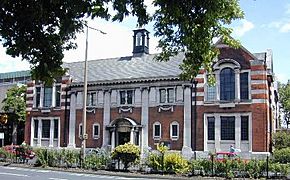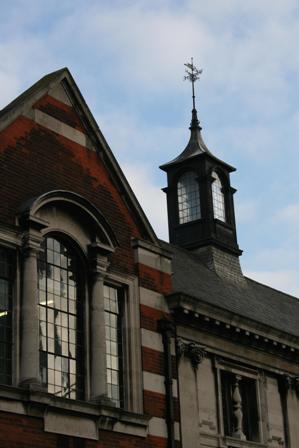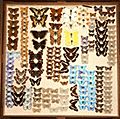Southend Central Museum facts for kids

Central Museum, Southend
|
|
| Lua error in Module:Location_map at line 420: attempt to index field 'wikibase' (a nil value). | |
| Established | 1981 |
|---|---|
| Location | Southend-on-Sea, Essex |
| Type | Local history |
| Key holdings | Prittlewell Anglo-Saxon burial; The London shipwreck |
| Collections | Costume, fine art, local history, natural history, archaeology |
| Architect | Henry Thomas Hare |
| Owner | Southend-on-Sea City Council - Southend Museums |
| Public transit access | |
The Southend Central Museum is a cool place to visit in Southend-on-Sea, Essex, England. It's full of amazing collections about local history and nature. You can even explore space in its special planetarium, which was built by astronomer Harry Ford in 1984.
The museum first opened its doors in April 1981. Before that, the building was Southend's very first free public library. The library moved to a new, specially built location in 1974.
Contents
The Museum Building
The museum building itself has a long history. It was originally built in 1905 to be a free library. A famous businessman named Andrew Carnegie gave £8,000 to help build it. The architect who designed this building was Henry Thomas Hare. In 1974, the building was given a special status called "Grade II listed." This means it's an important historical building that needs to be protected.
Amazing Collections to Explore
The Southend Central Museum has many interesting things to see.
Old Radios and Local History
One special collection shows original Ekco radios. These radios were made by a company called E.K. Cole & Co. Ltd., or 'Ekco', right here in Southend. In the 1930s, Ekco was one of the biggest radio makers in Britain! The museum also has displays about the local history of Southend and its natural environment. You can learn about the plants, animals, and people who have lived here over many years.
Shipwrecks and Ancient Treasures
In September 2018, the museum opened a big exhibition. It showed amazing items found from the wreck of the HMS London. This was a large warship from the 1600s that exploded and sank in the Thames Estuary in 1665. The exhibition was open until July 2019.
In May 2019, a brand new gallery opened. This gallery displays incredible archaeological finds from the Royal Saxon tomb in Prittlewell. This is an Anglo-Saxon burial mound found in the area of Prittlewell. It was discovered in 2003 when workers were making a road wider.
The Prittlewell Royal Burial
During the excavations, many Anglo-Saxon objects were found. These items showed that it was a very important burial, likely for someone of high status like a king or a prince. Scientists used a method called carbon dating to figure out the age of the burial. They believe it happened around 580 AD. Some experts think it might have been the tomb of Sæxa, who was the brother of Sæberht, a king of Essex.
Images for kids




